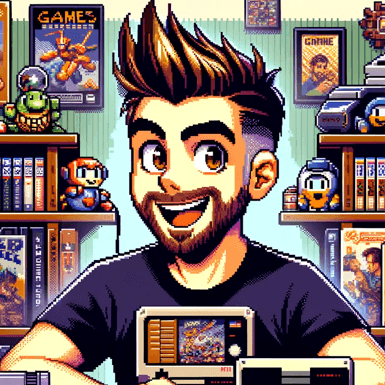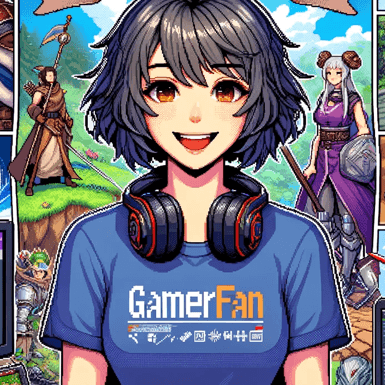 Quick fun fact while I tap the Start button — Prince of Persia was created by Jordan Mechner and published by Brøderbund. Broderbund’s been a household name on the PC for puzzle and edutainment hits for years, and here they backed a small-team auteur piece that feels more like a short film than a typical platformer. Mechner even rotoscoped real footage — he filmed his brother running and fighting to get those eerily smooth animations. It shows every time our hero turns, slides, or stumbles.
Quick fun fact while I tap the Start button — Prince of Persia was created by Jordan Mechner and published by Brøderbund. Broderbund’s been a household name on the PC for puzzle and edutainment hits for years, and here they backed a small-team auteur piece that feels more like a short film than a typical platformer. Mechner even rotoscoped real footage — he filmed his brother running and fighting to get those eerily smooth animations. It shows every time our hero turns, slides, or stumbles.
 I can see why that technique is getting people excited. The movement is so deliberate; it makes every jump and parry feel weighty. We’re on the third level and the way the Prince catches himself on the ledge is almost poetic. But remember: we have one hour on the clock to get to Jaffar. I’m feeling the pressure already — this game is tense because death sends you back to the start of the level.
I can see why that technique is getting people excited. The movement is so deliberate; it makes every jump and parry feel weighty. We’re on the third level and the way the Prince catches himself on the ledge is almost poetic. But remember: we have one hour on the clock to get to Jaffar. I’m feeling the pressure already — this game is tense because death sends you back to the start of the level.
 That restart rule is the double-edged sword. On the one hand, it makes success feel earned — stringing several rooms together without dying is genuinely thrilling. On the other, a single mistimed jump over spikes forces a long redo. The controls are tight, but the level design asks for patience more than twitch reflexes. This is cinematic platforming in a nutshell.
That restart rule is the double-edged sword. On the one hand, it makes success feel earned — stringing several rooms together without dying is genuinely thrilling. On the other, a single mistimed jump over spikes forces a long redo. The controls are tight, but the level design asks for patience more than twitch reflexes. This is cinematic platforming in a nutshell.
![]()
 Gameplay highlights so far: the rotoscoped animation, the swordplay that requires timing and feints rather than button-mashing, and the environmental puzzles — pressure plates, rising portcullises, and the occasional hidden switch. The atmosphere is also a highlight; brooding music, torch-lit corridors, and that constant sense that one wrong step means you return to a save far behind.
Gameplay highlights so far: the rotoscoped animation, the swordplay that requires timing and feints rather than button-mashing, and the environmental puzzles — pressure plates, rising portcullises, and the occasional hidden switch. The atmosphere is also a highlight; brooding music, torch-lit corridors, and that constant sense that one wrong step means you return to a save far behind.
 Agreed. The sword fights are the best kind of simple but skillful. Guard choreography forces you to parry before attacking. If you rush, you lose health fast. Also, finding a large jar that permanently increases your health is a fantastic moment — I still remember that little victorious roar when my Prince got his fourth heart.
Agreed. The sword fights are the best kind of simple but skillful. Guard choreography forces you to parry before attacking. If you rush, you lose health fast. Also, finding a large jar that permanently increases your health is a fantastic moment — I still remember that little victorious roar when my Prince got his fourth heart.
 We should jot down hot tips while we play. The hour limit makes time management crucial.
We should jot down hot tips while we play. The hour limit makes time management crucial.
![]()
- Hot Tip 1: Learn to bait guards into attacking and then counter. Blocking then riposting saves health.
- Hot Tip 2: Use ladders and ledges to avoid some encounters when possible — it’s sometimes faster to sneak past than fight.
- Hot Tip 3: Conserve health potions; small pots restore, big jars increase max health — prioritize finding jars.
- Hot Tip 4: Memorize trap rhythms. Spike pits and floor blades have tells; rushes will end badly.
- Hot Tip 5: If you die, breathe. The restart is brutal, but practicing specific segments will shave seconds off your runs.
 The memorable moments keep stacking. Remember when you timed that long sideways jump over the pit with the crushing blade above? Felt movie-like. Also, the one-room puzzle with the pressure plate and the two statues — we almost missed the sequence that raises the portcullis.
The memorable moments keep stacking. Remember when you timed that long sideways jump over the pit with the crushing blade above? Felt movie-like. Also, the one-room puzzle with the pressure plate and the two statues — we almost missed the sequence that raises the portcullis.
 And the first time we saw the Princess at the start — it sets a simple but effective motivation. The narrative is straightforward: Jaffar kidnaps her, threatens forced marriage, and the Prince has an hour. It’s lean but gives the whole thing momentum. The final confrontation with Jaffar is surprisingly fitting: fast, unforgiving, and theatrical. He moves quickly and punishes reckless swings. Timing your lunges is everything.
And the first time we saw the Princess at the start — it sets a simple but effective motivation. The narrative is straightforward: Jaffar kidnaps her, threatens forced marriage, and the Prince has an hour. It’s lean but gives the whole thing momentum. The final confrontation with Jaffar is surprisingly fitting: fast, unforgiving, and theatrical. He moves quickly and punishes reckless swings. Timing your lunges is everything.
 I like the way the final duel mirrors the rest of the game — it’s about control, not pure aggression. Beat him with measured strikes and parries, and it feels earned. One anecdote: on my first complete run-through I lost all my small pots before the final door and faced Jaffar with two health bars. It was the nastiest five minutes of my gaming life, but when I finally landed the winning blow with ten minutes left on the clock, I nearly threw my joystick. This version rewards practice and memorization.
I like the way the final duel mirrors the rest of the game — it’s about control, not pure aggression. Beat him with measured strikes and parries, and it feels earned. One anecdote: on my first complete run-through I lost all my small pots before the final door and faced Jaffar with two health bars. It was the nastiest five minutes of my gaming life, but when I finally landed the winning blow with ten minutes left on the clock, I nearly threw my joystick. This version rewards practice and memorization.
![]()
 We should be candid about the rough edges. The level restart on death is the most divisive design choice. Also, sometimes the collision detection feels a hair unforgiving — especially on narrow ledges. That demands pixel-perfect jumps, which can frustrate players who came for more forgiving platformers. Lastly, the hour timer is a great source of tension but can feel punitive if you make a small mistake early on; you suddenly have to play flawless for a long stretch.
We should be candid about the rough edges. The level restart on death is the most divisive design choice. Also, sometimes the collision detection feels a hair unforgiving — especially on narrow ledges. That demands pixel-perfect jumps, which can frustrate players who came for more forgiving platformers. Lastly, the hour timer is a great source of tension but can feel punitive if you make a small mistake early on; you suddenly have to play flawless for a long stretch.
 The game’s presentation and pacing are strong, but those punitive systems keep it from being universally accessible. Still, for players who like a tough, cinematic challenge, it’s a rewarding ride. And I have to admit, that rotoscoped animation continues to impress; it gives the Prince personality you don’t often see in platformers.
The game’s presentation and pacing are strong, but those punitive systems keep it from being universally accessible. Still, for players who like a tough, cinematic challenge, it’s a rewarding ride. And I have to admit, that rotoscoped animation continues to impress; it gives the Prince personality you don’t often see in platformers.
 If you’ve got a Turbo button and an afternoon free, I recommend playing in short runs and learning segment by segment. Memorize guard placements, pace yourself in the sword fights, and resist the urge to rush. The extra levels on some console ports add variety, but this original—at its best—feels like a well-crafted short film you play, not just watch.
If you’ve got a Turbo button and an afternoon free, I recommend playing in short runs and learning segment by segment. Memorize guard placements, pace yourself in the sword fights, and resist the urge to rush. The extra levels on some console ports add variety, but this original—at its best—feels like a well-crafted short film you play, not just watch.
![]()
 That said, it’s a B-level classic: memorable, polished in many areas, and occasionally frustrating where it could’ve been more forgiving. Now watch me edge past this next trap and try not to die again — my last run still stings.
That said, it’s a B-level classic: memorable, polished in many areas, and occasionally frustrating where it could’ve been more forgiving. Now watch me edge past this next trap and try not to die again — my last run still stings.
more info and data about Prince of Persia provided by mobyGames.com
